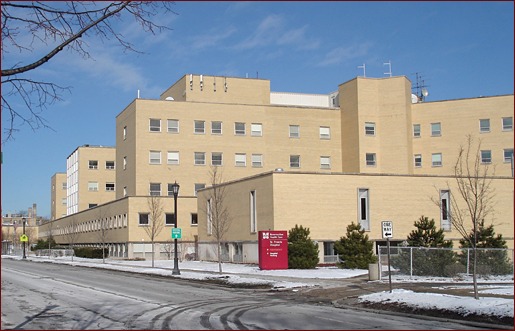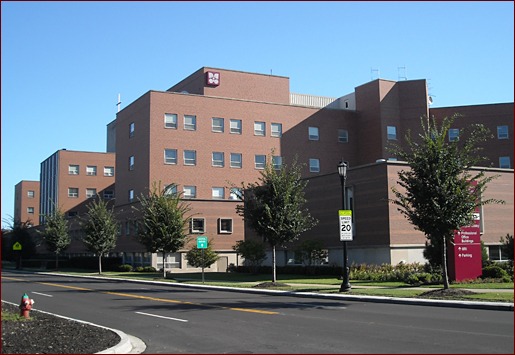August 2009
Staining ??? Case Study
Saint Francis Hospital
Evanston, Illinois
Saint Francis Hospital, in Evanston, Ill., was founded in 1901 in a two-story red brick building with limestone trim. Additions since then have created a 375-bed, full-service Level I Trauma Center specializing in emergency and cardiac care.
When Saint Francis Hospital joined the Resurrection Health Care system in 2000, investments were made in infrastructure, technology and patient care programs, which positioned the facility to give high-quality care to the community as it moves into the 21st century.
A market study initiated in 2007 revealed a negative public perception of the facility, based on its architectural character and color. Focus groups consistently selected photographs of other hospitals over those of Saint Francis, citing the faded yellow color of the masonry fa??ade as indicative of a low-quality facility with sub-par staff and technology.
Management was concerned that the building’s appearance did not communicate the positive changes and investments that had been made to the facility, and decided to embark on a fa??ade maintenance program culminating in the staining of the entire building.

Before

Design process
Loebl Schlossman and Hackl was selected to develop a strategy for refurbishment of the hospital exterior, which included addressing the results of the market study.
The building fa??ade had become, for the focus groups, a reflection of the quality of care, technology and people within. The dated, faded yellow colors of brick were connecting with the public but delivering the wrong message. The opinion was that the fa??ade color triggered negative impressions on an emotional level. It was not warm, welcoming or approachable, and it seemed rather impersonal, cold and aloof.
Photographs of the existing building and other prominent buildings in the area were studied, and three color schemes were developed for review. The general colorations were based on the responses of focus groups to photographs of medical facilities and review of the colorations of brick blends commercially available and used in the area. Each scheme was presented in a “before” and “after” comparative format executed in Photoshop.
Each component of the three color schemes was mocked at the hospital on a south facing wall for review. The finalist in the process was refined in two subsequent work sessions. The approved mockup was left in place for reference in all discussions regarding quality of the application, color consistency or density.
The selected color scheme is comprised of a darker and lighter three-color blend; the darker blend is used on the base of the building, and the lighter on the wings above. Feature bands of a single color, three courses in height subdivide the darker colored, lower mass of the composition. The color of the feature band is the lightest of the three colors that comprise the lighter blend used on the upper portions of the building.
Cost estimates were prepared during the design process. The project timeline was adjusted as the scope of the restoration, and tuck pointing was refined. At the end of the design phase, a clear understanding of the project scope, cost and the time of application had been developed.
Product selection and application
A water-based masonry stain was selected that complies with the Environmental Protection Agency’s Volatile Organic Compound regulations. The application process is environmentally friendly, there are no chemical odors produced while drying, and all tools are cleaned with water.
Masonry stain does not change the texture of brick, block or mortar. It is absorbed into the substrate that it is applied to, creating a uniform and natural appearance. Stains can be used to match the color of brick that is no longer available, blending additions into an existing context, or to conceal patches and graffiti.
Designed to penetrate into the substrate carrying the UV-resistant pigments that create the new appearance, masonry stain was the ideal choice for use in the re-coloring of the fa??ade. The staining process does not seal the wall surface; moisture naturally evaporates though the wall construction, and the stain does not support the growth of mildew. The product specified for Saint Francis Hospital was manufactured by Nawkaw, a company based in Athens, Ga., that is involved in both the masonry and concrete industries. Nawkaw provides full-service contracting services for the application of their proprietary product offerings.
A crew of eight applicators using three swing stages worked consistently over a seven-month period to hand-apply the range of stain colors required to create the approved color scheme. A 150-foot crane was also used to reach several areas of the facility, including a smokestack.
The fa??ade improvements began with a power wash of the fa??ade using a light-duty masonry cleaner manufactured by Prosoco. Deteriorated masonry joints were re-pointed with type N mortar. Hand-tooling techniques were used where power grinders equipped with vacuum bags could not be used.
The stain concept for Saint Francis Hospital was applied in two passes. The first step was the application of the base color. This was done by hand with rollers the height of a single brick. The second pass consisted of two additional colors being randomly applied by roller to create the flashed appearance of clay-fired masonry. Mortar was only stained in areas where previous patches had occurred without a good color match.
Weekly project meetings facilitated development of solutions to unforeseen problems, and provided the opportunity to review the project schedule and the quality of the work.
Conclusion
The brick staining of Saint Francis Hospital was successful in the creation of a new appearance for the facility at a price significantly less than that required to replace the existing masonry face brick. Normal operations at the facility were not impacted by the fa??ade improvement program, and the owner is actively considering other opportunities to take advantage of the benefits of masonry stain.